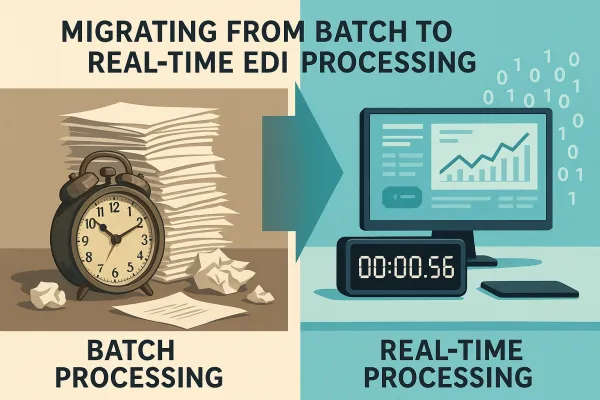The September 27 Deadline: CBP's New Auto-Reject Rules Are Breaking EDI Systems - Here's Your Emergency Compliance Checklist

CBP's new enhancement auto-rejects cargo filings missing sufficient cargo descriptions, shipper, or consignee names, with the official rollout to the ACE Production Environment scheduled for September 27, 2025. If your EDI system hasn't been tested against these changes yet, you're potentially looking at automated rejections that could paralyze your import operations in just weeks.
The timing couldn't be worse. The sudden reclassification of imported goods under Trump's "Liberation Day" reciprocal tariffs is overwhelming systems like CBP ACE and creating confusion across freight and compliance teams, with entry rejection rates spiking post-April 2, especially for shipments originating in China, the EU, and Latin America. Your EDI systems are now facing a perfect storm of compliance challenges that require immediate attention.
September 27 Changes Everything for CBP EDI Compliance
This update enables automated rejection of manifest and cargo release filings that contain insufficient cargo descriptions, shipper names, or consignee names. Unlike previous manual review processes, these rejections happen automatically without human intervention. Applied updates span air, ocean, rail, and truck manifest implementation guides, with testing now live in ACE Certification Environment (CERT).
Here's what triggers automatic rejection:
- Generic cargo descriptions like "goods," "merchandise," or "parts"
- Missing or incomplete shipper/consignee company names
- Vague commodity descriptions that don't meet CBP's specificity requirements
- Incomplete address information in party data
The most problematic change? CBP has added new disposition codes: 8H – Invalid Cargo Description Hold Placed, 8I – Invalid Cargos Description Hold Removed, 9H – Invalid consignee Hold Placed, 9I - Invalid Consignee Hold Removed, 4H – Invalid Shipper Hold Placed, 4I – Invalid Shipper Hold Removed, 6H – No Load, 6I – Release of No Load. These codes will start appearing in your EDI 315, 322, and 404 manifest transactions immediately after September 27.
The Tariff Complication: When HTS Codes Meet EDI Automation
While you're dealing with manifest validation changes, the new tariff landscape is creating additional EDI complications. In early April 2025, the U.S. government implemented sweeping tariff increases that overlay on top of the existing HTS duty rates, meaning importers must pay an extra 10% duty on the customs value of goods in addition to the normal tariff rate determined by the product's HTS code classification.
This dual-layer complexity is breaking EDI systems in unexpected ways. Outdated HTS codes are triggering rejections in CBP's ACE system, while unmapped reciprocal tariff rules are leading to missing or incorrect duty data. Your EDI mapping tables likely don't account for these new tariff calculations, causing downstream errors in invoice processing and duty payments.
The bigger issue? Many EDI systems are hardcoded with HTS classifications that worked fine under previous tariff structures but now fail validation under the new reciprocal tariff framework. For instance, imports from Vietnam might face a 46% surcharge, while products from Lesotho see a 50% tariff, among other country-specific rates, with these percentages stacking on top of the normal HTS duty as well.
Emergency Assessment: Audit Your Current EDI Setup Now
Start with your most critical trading partners and work backward. Here's your immediate action checklist:
Test Against ACE CERT Environment: Testing is now live in ACE Certification Environment (CERT). Run your typical manifest submissions through CERT to identify rejection patterns before September 27.
Review Cargo Description Standards: Pull your last 30 days of manifest submissions and flag any descriptions under 10 characters or containing generic terms. CBP is specifically targeting vague commodity descriptions.
Validate Party Data Completeness: Check that your shipper and consignee name fields contain complete company names, not abbreviations or codes. Missing or abbreviated party information is now an automatic rejection trigger.
EDI Transaction Code Review: Update your error handling for new disposition codes 4H, 4I, 6H, 6I, 8H, 8I, 9H, and 9I. Your current EDI processing likely doesn't recognize these codes, which could cause silent failures.
The 72-Hour Fix: Critical Updates You Must Make
Time is running short, but these changes can be implemented quickly if you prioritize correctly:
Immediate Data Validation Updates: Implement pre-submission validation that flags cargo descriptions shorter than 15 characters or containing words like "goods," "parts," "merchandise," or "materials." This catches problems before CBP does.
Partner Communication Templates: Send standardized notifications to your key trading partners explaining the new requirements. Include specific examples of acceptable vs. unacceptable cargo descriptions.
EDI Platform Updates: Whether you're using Cleo, SPS Commerce, TrueCommerce, or IBM Sterling, verify your platform supports the new disposition codes. Based on a mix of analyst input, user reviews and surveys, top EDI providers in 2025 include managed service providers like SPS Commerce and TrueCommerce, which follow managed services-first approaches, while OpenText is mostly known as a VAN, offering managed service offerings.
Fallback Procedures: Create manual override processes for rejected manifests. When automated systems fail, you need quick manual alternatives to prevent cargo holds.
Long-term Strategy: Building Resilient EDI Compliance Systems
Beyond the immediate crisis, build systems that adapt to future compliance changes automatically.
Real-time Validation: Implement validation rules that check manifest data against CBP requirements before transmission. This should include commodity description length, party name completeness, and HTS code validity under current tariff structures.
Automated Monitoring: Set up alerts for disposition codes 4H through 9I that immediately notify your compliance team. These aren't just errors - they're compliance failures that can trigger audits.
Scalable Partner Onboarding: Create standardized procedures for bringing new trading partners online that meet September 27 requirements from day one. Document acceptable cargo description formats and share them during partner setup.
For companies managing complex multi-modal logistics, modern TMS platforms like Cargoson, MercuryGate, and Descartes offer integrated compliance checking that can catch these issues before they reach CBP. A transport management system is software that helps businesses to manage their logistics and transport needs, optimizing the distribution of products and ensuring they are delivered on time, with modern European TMS platforms like Cargoson bridging the gap between complex enterprise systems and simple shipping tools.
Industry Impact: What This Means for Different Transportation Modes
Air Cargo: The impact hits air freight hardest due to shorter transit times and higher transaction volumes. CBP must receive the required cargo information no later than the time of departure for aircraft from nearby foreign areas including Mexico, Central America, South America (from north of the Equator only), the Caribbean and Bermuda. There's no buffer time to fix rejected manifests.
Ocean Freight: Container shipments have more flexibility due to longer transit times, but the volume of transactions amplifies the impact. A single auto-rejection can affect hundreds of containers on one vessel.
Trucking and Rail: Cross-border trucking faces immediate challenges since many trucking companies rely on abbreviated commodity descriptions to save time. Rail intermodal operations combining with truck movements create additional validation complexity.
Comprehensive TMS solutions help manage these multi-modal compliance requirements by standardizing data across all transportation modes. MercuryGate is built for businesses managing multi-modal logistics, offering real-time tracking, optimized carrier selection, and final-mile delivery solutions, with its data-driven approach enhancing compliance tracking and visibility across the entire supply chain.
Your Next Steps: Don't Wait Until September 27
The September 27 deadline isn't negotiable, and the current tariff complications make this more complex than a simple EDI update. Here's what you need to do this week:
Schedule ACE CERT Testing: Block out time to test your most common manifest types against the new validation rules. Focus on your highest-volume trading partners first.
Inventory Your EDI Platforms: Document which versions of Cleo, SPS Commerce, TrueCommerce, or other platforms you're running. Contact your vendors about disposition code updates and validation rule changes.
Create a Compliance Calendar: Map out the remaining time between now and September 27. Include testing phases, partner communications, and system updates.
Establish Emergency Protocols: Prepare for the reality that some manifests will be rejected on September 27 despite your best efforts. Have manual processes ready and know who to call at CBP.
The companies that survive this transition will be those that treat it as an opportunity to modernize their EDI infrastructure rather than just patch existing systems. The rise of Transport Management Software in 2024/2025 represents a paradigm shift in the logistics and transportation industry, with companies that adopt and adapt to this technology leading the way in the transport industry's evolution. The question isn't whether you'll be affected by the September 27 changes - it's whether you'll be ready.





